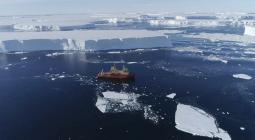Antarctic glacier shows fastest retreat in modern history
In 2022, something shocking happened to the Hektoria Glacier, a small river of ice that slips into the sea near the tip of the Antarctic Peninsula. Over 16 months, it retreated by 25 kilometers, and it lost a whopping 8 kilometers in just two of those months—the fastest glacial retreat in the modern record. Now, after a forensic analysis of the event reported today in Nature Geoscience, researchers say they have identified the worrisome mechanisms behind it: a combination of glacial earthquakes and a swath of thinned ice popping afloat and breaking apart in a geological instant.
If the same processes were to occur at larger Antarctic glaciers, they could rapidly accelerate the retreat of ice sheets and raise global sea levels, says Jeremy Bassis, a glaciologist at the University of Michigan. The study is “telling us that those worst-case scenarios are maybe not as implausible as some people might have thought.”
To figure out what happened to Hektoria, the researchers first had to establish its original grounding line: the point at which a glacier is no longer attached to bedrock and becomes a floating ice tongue. Using satellite data on the height of the ice surface, as well as images of surface depressions—a marker of thin, floating ice with cracks underneath—they determined that half of the 25 kilometers of lost ice had been grounded.
Using additional satellite data, the team then worked backward to develop a theory explaining how both grounded and floating ice retreated. Their scenario begins 20 years earlier, when Hektoria fed into the Larsen-B ice shelf, a massive, Rhode Island–size, 200-meter-thick slab of ice. Larsen-B broke up spectacularly in 2002, undamming Hektoria, which initially retreated. In the years that followed, sea ice formed and thickened, slowing the glacier and keeping it in place for more than a decade.
But at the same time, Hektoria’s ice was stretching and thinning out across the flat bedrock underlying it, forming what’s known as an ice plain. Warmer ocean temperatures, meanwhile, began to prevent sea ice formation in the surrounding Weddell Sea, exposing Hektoria’s usually protected waters. When storms sent large waves crashing into its margin in 2022, they cleared out the sea ice and Hektoria’s 12 kilometers of floating ice broke up into icebergs.
With the buttressing effect of the floating ice gone, Hektoria’s ice plain began to float, periodically rising and falling with the tides until it lifted fully off its bedrock and began snapping apart into smaller icebergs. This process, called buoyancy-driven calving, has been observed before, when a glacier slides into deeper water like an alligator off a bank. But lead study author Naomi Ochwat, a glaciologist at the University of Innsbruck, says Hektoria experienced something much more abrupt. “If you thin the glacier enough, a whole region [can] go afloat at once.”
More damage followed when the force of the breakup flipped some of the icebergs “toes out,” momentarily reversing their momentum into the glacier behind them. These bumps generated glacial earthquakes that were detected by a network of seismic instruments. With the shock waves rumbling through it, the rest of the ice plain broke free.
The one-two punch of flotation and quakes was enough to account for Hektoria’s 8 kilometers of retreat over 2 months, a pace that’s an order of magnitude faster than any in the modern record. “The numbers are incredibly out of this world, much higher than anything we have been able to observe,” says Mathieu Morlighem, a glaciologist at Dartmouth College. Afterward, a final few grounded kilometers of ice calved into the sea before the remaining glacier slid to a resting state on higher bedrock.
The researchers “pieced together a very nice narrative for the story of how this system evolved over several decades,” says Helen Amanda Fricker, a glaciologist at the Scripps Institution of Oceanography. In the aftermath of Larsen-B’s crackup, it’s “bringing in further processes that are really important for us to understand to predict the future.”
Bassis wonders whether the same kind of catastrophic calving could occur at the much larger Thwaites Glacier, which is sometimes called the Doomsday Glacier because its retreat could unleash more than 3 meters of global sea level rise. Scenarios of runaway retreat at Thwaites usually focus on how, interior to its grounding line, the bedrock dips downward, which could allow warm seawater to invade and melt the ice shelf from below. But Thwaites likely also once had an ice plain, which could help explain some of its retreat. And although the shrinking sea ice at Thwaites hasn’t yet shown effects, Hektoria shows it can be “like putting a Tonka toy in front of a bulldozer, and yet … as soon as it goes away, pretty dramatic changes happen,” Bassis says.
The processes at work on Hektoria highlight a crucial gap in glaciologists’ models of Antarctic ice loss, Morlighem says. They also show a need for instruments that can detect a glacier becoming unmoored from its bedrock, says Eric Rignot, a glaciologist at the University of California, Irvine. Buoyancy-driven calving could be “the monster sleeping in our backyard,” he says. “It shows us what other Antarctic glaciers could do in a warmer climate.”
Cover photo: Rapid retreat of grounded Antarctic glaciers is raising global sea levels.Sylvain Cordier/Biosphoto/Minden



